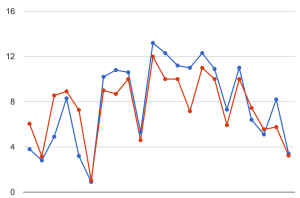
Today’s guest post come from Cleveland Cavaliers’ High Performance Director Alex Moore. Before joining the Cavs, Moore was the Strength and Conditioning coach for the United States Ski Team where he served for six years.
With an ever-increasing number of technologies available to monitor athletes, it can be hard to know what to use and then what to do with the information they provide. The last ten years has seen a proliferation of tracking systems (both internal and external load) ranging from basic heart rate monitoring to more sophisticated GPS and camera tracking systems. When choosing a system it is necessary to consider budget, ease of use and also how many staff members you have available to collect and deliver the information to athletes and coaching staff.
Over the last couple of years many college and professional teams have purchased tracking systems, given them to a Strength Coach and tasked him/her with the job of figuring how they can help the team. Often these Strength Coaches don’t have the necessary time or experience to create meaningful information and after a period of time the technologies either get shelved, or worse, continue to be collect information that never leaves a spreadsheet. These technologies can spit out thousands of data points with hundreds of potential metrics.
So how can you make sense of the numbers? The bad news is that once you have decided on a system, you need to realistically collect an entire years’ worth of data before you can use it to make critical decisions. In my experiences it is better to initially focus on the most basic metrics and build from there. With so much information you can end up looking at so many different variables that they start to make no sense at all. To have actionable items the initial goal should be to make it as simple as possible. At the most basic level you should begin with two main variables:
Load – The amount of work done. Basic questions that you will need to answer include: How much total work did each athlete do in practice?How much total work did each athlete do in the game?Does training reflect the games in terms of the amount of work done?Is there a point where too much load starts to lead to chronic injuries? If so, what is each individual’s threshold for this?
Intensity – A measure of how hard practice and games are. This is usually calculated as load/time but can also be factors such as the number of high velocity sprints or time spent above certain speed zones. Questions that these can answer include: Does the intensity of practice adequately represent the intensity of the games?If the athlete is fatigued, do they noticeably drop intensity?Is there any relationship between too much intensity and injuries (particularly soft tissue)?
Once you have established these main two variables then you can look to expand your focus. The most important component to this process is being able to provide the coaching staff and players with very simple and easy to understand information.

The Sparta Software™ provides very simple to view graphical information and allows us to easily compare athletes and also look at trends.We cannot show or discuss real Cavaliers’ data so have included a generic picture to the right from the Sparta Software™, similar to the visuals we would see over time on players’ volume or intensity. Over time, you can compare this information to performances and also injury trends. Unfortunately, injuries are part of every sport, but having readily viewable information allows you to essentially audit the injury and see if there were any trends leading up to the injury. This may in time provide you with an injury prevention strategy for your athletes.
Once you have the simple variables of Load and Intensity, we use those markers and subsequent trends to
• Guide practice volumes and intensities • Have ammunition to make sure your athletes have adequate rest at the right times and in many cases do more work (or at a higher intensity) • Bring an athlete back from injury in the appropriate fashion with reference to what is demanded from them in terms of both volume and intensity • See if there are any trends between training loads/intensities and game performances